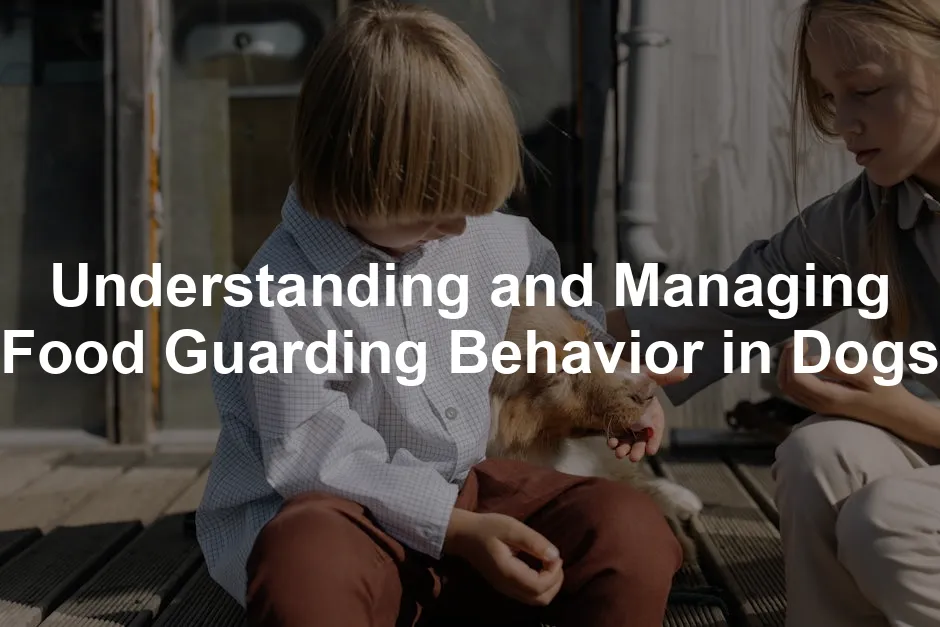Obvious signs include:
- Growling: A low rumble that signals discomfort.
- Snapping: A quick bite that serves as a warning.
- Biting: In more extreme cases, this can happen if a dog feels threatened.
Less overt signs can include:
- Stiff Body Posture: Your dog may suddenly become rigid when approached.
- Avoiding Eye Contact: A dog may look away to avoid confrontation.
- Rapid Eating: If your dog gobbles down food as if it’s a race, they might be guarding against perceived threats.
Other behaviors include lowering their body posture, blocking access to items, or even running away with their food or toys. These subtle signals can indicate a dog’s internal anxiety about losing something they value. Paying attention to these signs can help you intervene before the behavior escalates, ensuring a happier and safer environment for both you and your furry friend.
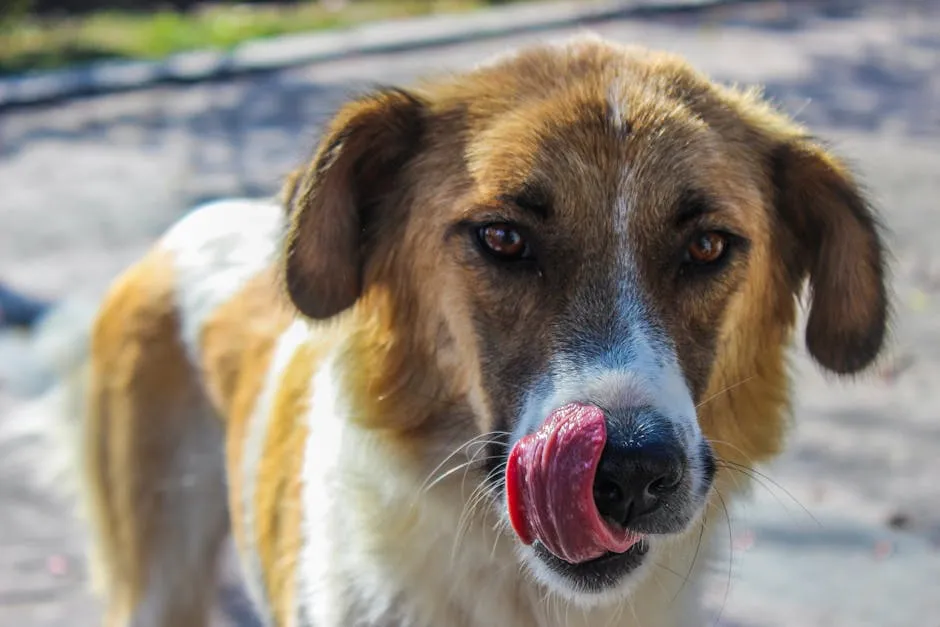
Causes of Food Guarding Behavior
Psychological Factors
Food guarding behaviors often stem from psychological issues. Anxiety and fear are major players here. If a dog has experienced trauma, they may become defensive over their possessions. For instance, a rescue dog might have been in a situation where food scarcity was a real threat, leading them to protect their resources fiercely.
Genetics can also play a role. Certain breeds, like terriers, might be more prone to guarding behaviors due to their history. They were bred to hunt and protect, which can translate into more significant guarding instincts. Understanding these psychological factors is crucial for addressing the root causes of food guarding.

Environmental Influences
The environment where your dog lives can heavily influence their guarding behavior. For instance, multi-dog households often lead to competition for resources. If dogs are fed together, they might feel the need to guard their food bowls against their siblings.
Moreover, a lack of socialization can exacerbate guarding behaviors. Dogs that haven’t been exposed to various situations and people may view new encounters as threats. This fear can lead to increased guarding tendencies. By ensuring a well-managed environment and promoting positive socialization, you can help mitigate these behaviors before they become problematic.
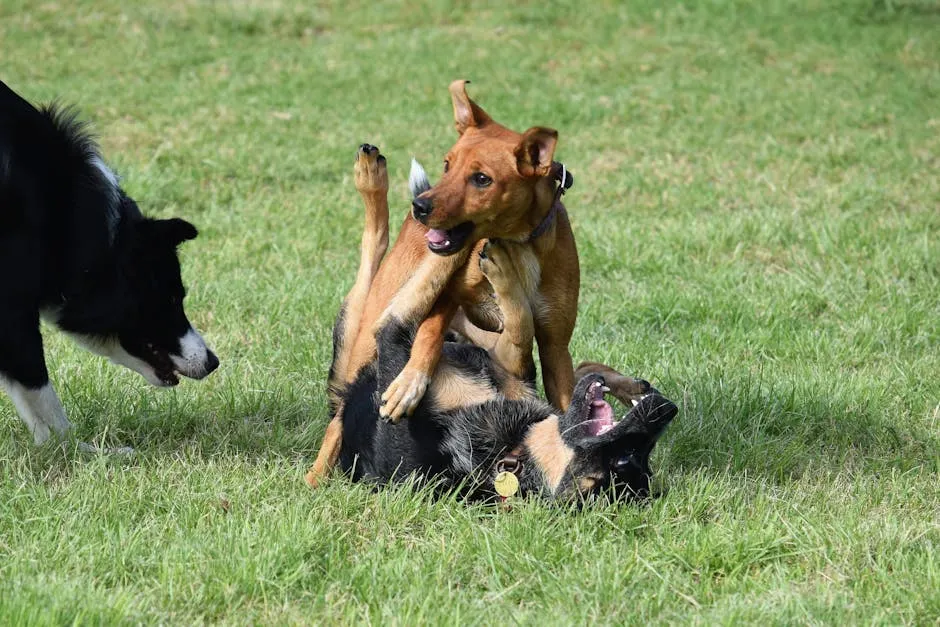
Managing Food Guarding Behavior
Immediate Steps to Take
If your dog displays food guarding behavior, it’s crucial to act wisely. First, observe from a distance. Allow your furry friend to enjoy their meal without interruption. Approaching a dog during mealtime can trigger anxiety and aggression. Your presence should be a source of comfort, not a threat.
Never punish or scare your dog. This approach can backfire, worsening their anxiety. Instead, let them know that you’re not a threat. If you must approach, do so calmly. Avoid sudden movements and loud noises. This helps create a safe environment for your dog.
If guarding behavior escalates, consider creating a feeding schedule. Feeding in a quiet area can reduce distractions and minimize competition, especially in multi-pet households. If your dog feels secure while eating, they’re less likely to guard their food.
In extreme cases, consult a professional dog trainer or behaviorist. They can provide tailored advice and support, ensuring that you and your pet navigate this behavior effectively. Remember, your goal is to foster trust and understanding, not fear. With the right approach, your dog will learn that sharing space around food can be a positive experience.
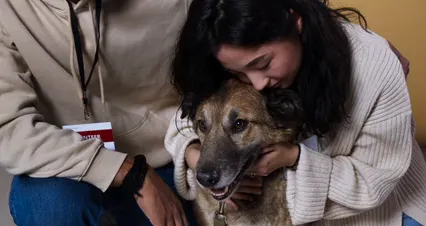
Training Techniques
Positive Reinforcement is your best friend when tackling food guarding. Use treats and praise to encourage sharing behavior. For instance, while your dog eats, drop tasty treats near their bowl. This teaches them that your presence brings good things. Over time, they’ll associate you with positive experiences, reducing anxiety.
Next, consider Desensitization and Counterconditioning. This technique involves gradually exposing your dog to your presence during mealtime. Start by standing a distance away while they eat, then slowly decrease that distance over time. Each time they remain calm, reward them with treats. This helps change their emotional response, making them feel more secure when you’re nearby.
Another effective method is Trade-Up Exercises. Teach your dog that relinquishing an item leads to better rewards. For instance, if your dog has a toy, show them a higher-valued item, like a squeaky toy or a treat. Encourage them to drop the first item to get the better one. This way, your dog learns that sharing can be rewarding!
Incorporate these techniques consistently. With patience and practice, your dog will develop a more positive attitude toward sharing their food and toys.
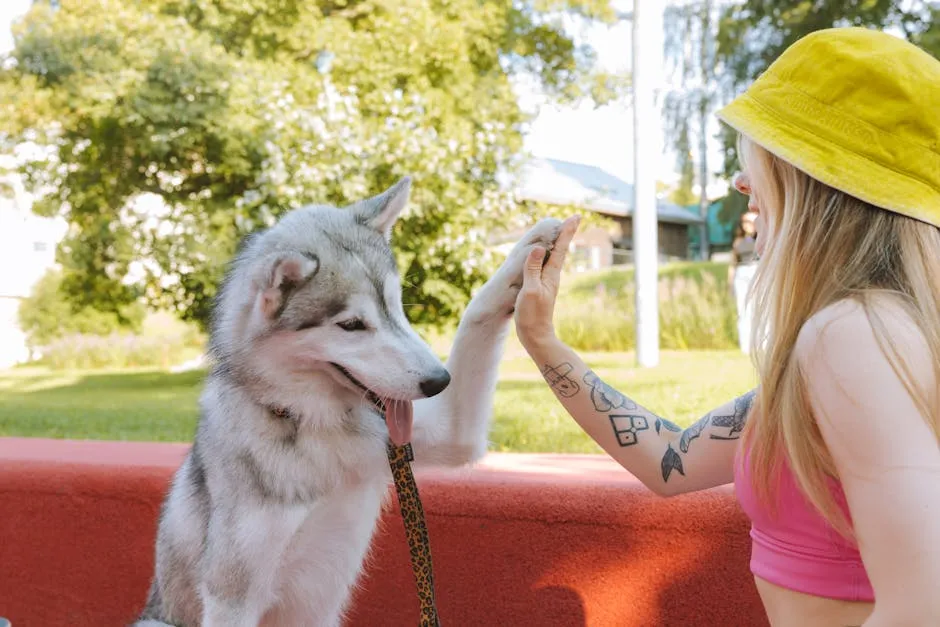
Preventing Food Guarding Behavior
Early Intervention Strategies
Prevention is key when it comes to food guarding. Start by training your puppy early. This sets the foundation for positive behavior around food and toys. Use consistent positive experiences to build their confidence. When your puppy is eating, drop treats nearby. This teaches them that your presence is a positive experience, reducing the chances of guarding behavior developing.
Also, ensure that your puppy has access to plenty of food and toys. The more resources they have, the less likely they’ll feel the need to guard them. Create a safe space for meals, away from distractions. Supervise playtime with toys, and encourage sharing. Use games that promote cooperation and sharing, fostering a sense of security in your puppy.
Lastly, consistently engage in socialization. Expose your puppy to various environments, people, and animals. This builds their confidence and reduces fear-based guarding behaviors. By implementing these early intervention strategies, you set your puppy up for success. A well-adjusted dog is less likely to develop food guarding behaviors as they grow.
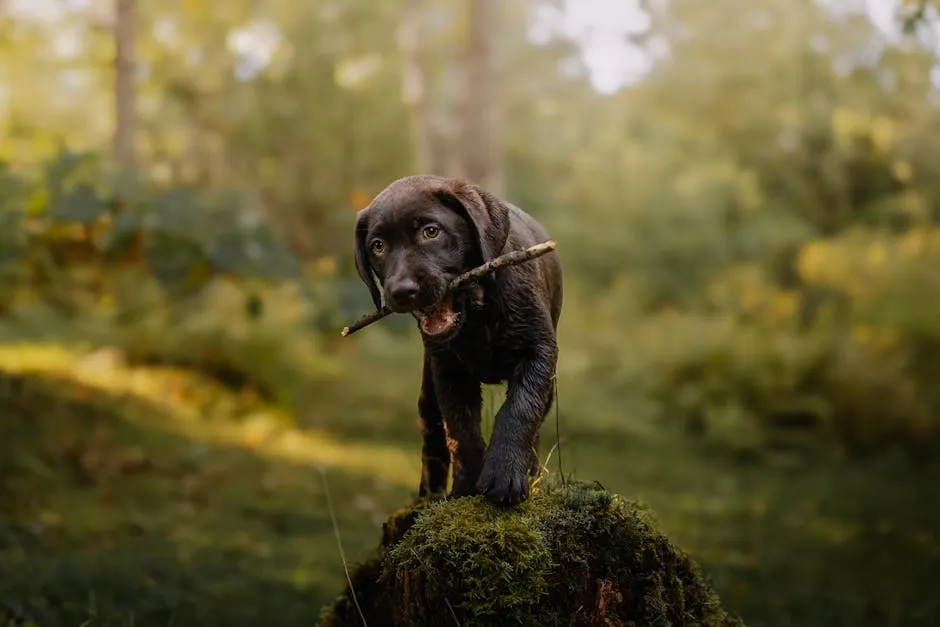
Managing Multi-Pet Households
In multi-pet households, competition for resources can spark anxiety and food guarding behaviors. To create a peaceful atmosphere, establish clear feeding and playtime routines. Feeding pets separately is a great first step. Designate specific areas for each pet during mealtime. This way, they can chow down without feeling threatened by their housemates.
Consider using feeding stations with barriers or gates to provide personal space. You can also try staggered feeding times. This keeps one pet busy while the other eats, reducing the urge to guard.
Playtime is another opportunity to minimize competition. Rotate toys regularly to keep things fresh and exciting. This way, pets won’t feel the need to guard their favorite items. Supervised play sessions can also help manage interactions. Always observe how your pets interact and step in if you notice signs of tension.
When children are involved, extra supervision is crucial. Kids may not understand a dog’s warning signs. Teach them to respect the dog’s space, especially during mealtime. Use baby gates to create boundaries, allowing pets a safe space. Remind children to avoid approaching dogs while they eat or play with their toys.
By implementing these strategies, you can foster a more relaxed environment for all your pets. The result? Happy pets and a harmonious home!
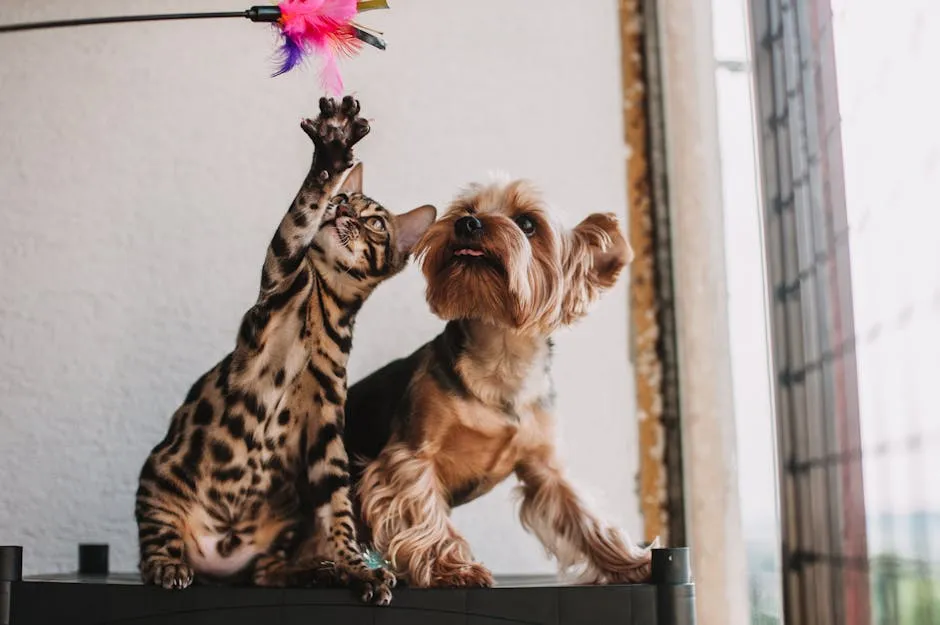
Creating a Safe Environment
Environmental Management
Creating a safe environment is vital for managing food guarding behaviors. Start by reducing potential triggers. Identify areas where your dog feels most anxious about resources. Keep high-value items out of reach. This includes toys, food bowls, and treats that could lead to guarding.
Providing separate spaces for feeding and playing is essential. Designate quiet areas for meals, away from distractions. This allows your dog to enjoy their food without feeling threatened. Use crates or playpens to create personal zones where dogs can retreat when feeling overwhelmed.
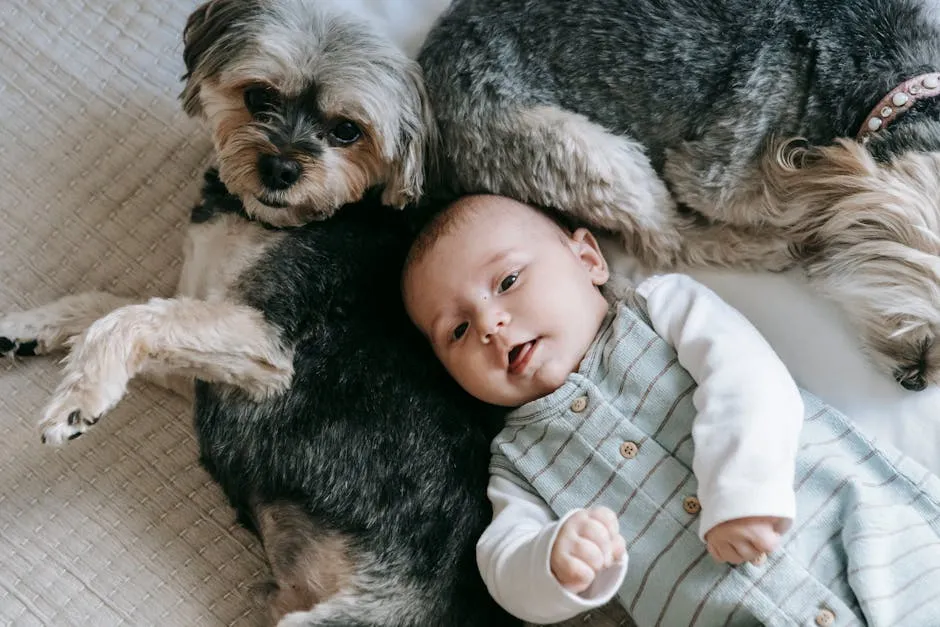
Consider using Puzzle Feeder Dog Bowls to prevent rapid eating. These help dogs take their time, reducing anxiety about finishing their meal too quickly. Encourage your dog to relax by adding some calming music or scents to their feeding area.
Lastly, keep an eye on the dynamics between pets. If you notice any aggressive behaviors, intervene quickly. Managing interactions effectively can significantly reduce the risk of food guarding.
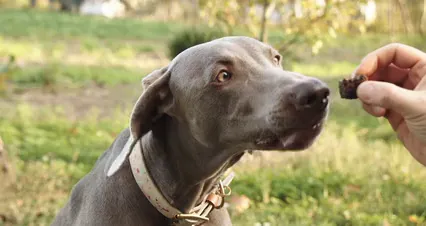
Encouraging Calm Behavior
Creating a relaxing atmosphere during mealtimes is crucial. Establish a consistent routine for feeding. Dogs thrive on predictability, and a regular schedule can help them feel secure. Feed your dog at the same time every day. This builds anticipation and reduces anxiety around mealtime.
Before meals, engage your dog in calming activities. Short walks or gentle play can help release pent-up energy. This way, they’re more relaxed when it’s time to eat.
During meals, avoid distractions. Turn off the TV and limit noise to create a peaceful environment. If your dog tends to rush their food, try hand-feeding or using a Dog Treat Dispenser Toy. This encourages slower eating, allowing for a more relaxed experience.
Also, reward calm behavior. If your dog remains relaxed while eating, praise them. This reinforces positive associations with mealtime. By fostering a calming environment and routine, you’ll help your dog feel more secure during meals, reducing the likelihood of guarding behaviors.
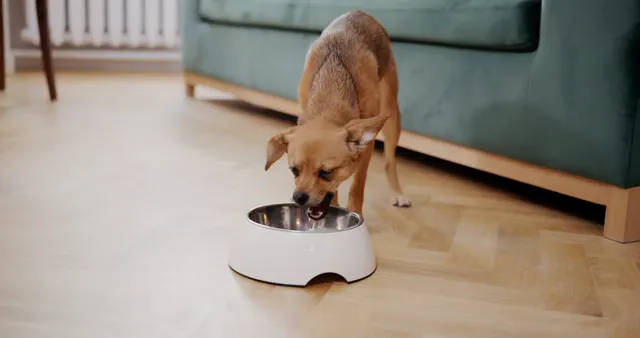
Conclusion
Understanding and managing food guarding behavior in dogs is vital for a harmonious household. When dogs feel the need to protect their food, it can lead to tension and stress, not just for them but for everyone involved. Recognizing the signs early on is crucial. Those little growls or food hoarding tactics are not just quirky habits; they signal deeper issues at play.
Addressing these behaviors begins with understanding their roots. Factors like past trauma, anxiety, or territorial instincts often contribute to this behavior. Thankfully, there are effective strategies you can use to help your dog feel secure in their environment. Patience and consistency are your best allies in this journey.
Using positive reinforcement techniques will encourage sharing and trust. With time and a sprinkle of professional guidance, you can transform those guarding instincts into a relationship built on cooperation and love. So, don’t despair if your dog seems overly protective of their food. With the right approach, you can help them learn that sharing can be just as rewarding as keeping it all to themselves. A little effort today can lead to a peaceful coexistence tomorrow!
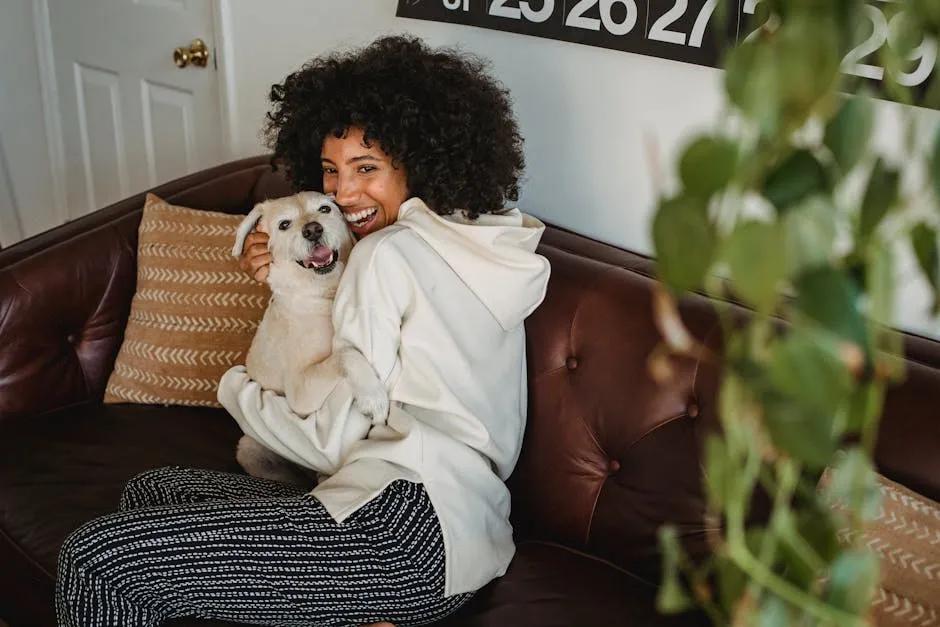
FAQs
Is resource guarding common in all dog breeds?
Resource guarding can occur in any breed. Some breeds, like terriers, may show this behavior more often due to their genetic predispositions. However, it’s important to remember that every dog is unique.
Can resource guarding be resolved completely?
While it may not disappear entirely, resource guarding can be significantly managed and reduced through consistent training and environmental adjustments. With the right approach, many dogs can learn to feel safe and secure without the need to guard.
What should I do if my dog bites when guarding?
If your dog bites while guarding, it’s crucial to seek professional help immediately. A behaviorist can provide tailored strategies to ensure everyone’s safety and improve your dog’s behavior.
How can I tell if my dog is resource guarding or just being protective?
Resource guarding often involves aggressive behaviors like growling or blocking access to items. In contrast, protective behavior is usually about alerting you to potential threats without the same level of aggression over resources.
Are there any professional resources available for training?
Yes! Look for certified trainers or behaviorists who specialize in resource guarding. They can offer personalized guidance and support to help you and your dog navigate these behaviors effectively.
Consider using a Dog Anxiety Vest to help your pup feel more secure during stressful situations. This can be especially beneficial in multi-pet households where competition for resources may heighten anxiety.
Please let us know what you think about our content by leaving a comment down below!
Thank you for reading till here 🙂
All images from Pexels
Understanding the motivations behind food guarding is critical. Factors such as past trauma, anxiety, and territorial instincts can contribute to this behavior. Fortunately, there are effective strategies to manage and prevent resource guarding, including positive reinforcement training, creating a safe environment, and fostering trust through consistent interaction.
Using positive reinforcement techniques can significantly help in managing food guarding behaviors. Learn more about effective techniques.
By employing techniques like desensitization, counterconditioning, and trade-up exercises, you can help your dog learn that sharing is a rewarding experience. Importantly, you should avoid punitive measures, as these can exacerbate fear and lead to aggression. Instead, focus on building a positive association with your presence around their food and belongings.
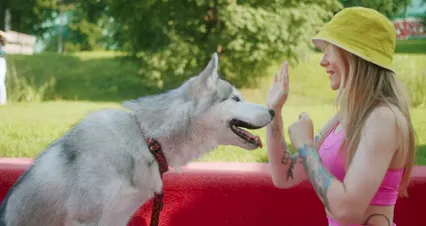
Also, consider investing in a Dog Training Book: “The Culture Clash” by Jean Donaldson. This book delves into the dynamics of dog behavior and offers insights that can help you understand your pup’s instincts better. With humor and clarity, it’s a must-read for any dog owner!
In this article, we’ll explore the nuances of food guarding behavior, practical tips for managing it, and provide insights on fostering a trusting relationship with your dog. Whether you’re a new pet owner or a seasoned dog parent, you’ll find actionable advice to create a peaceful coexistence with your four-legged friend.

Understanding Resource Guarding in Dogs
What is Resource Guarding?
Resource guarding is when a dog protects items they consider valuable, be it food, toys, or even their favorite sunny spot on the floor. This behavior can manifest in various ways. Some dogs may growl, snap, or even bite if they feel someone is too close to their prized possession. Others might simply freeze or stiffen up, sending a clear message: “This is mine, back off!”
But why do dogs exhibit such protective behaviors? It’s rooted in instinct. In the wild, dogs had to compete with others for limited resources. If they didn’t guard what they had, they risked going hungry. This survival instinct still lingers in our domesticated dogs, leading to food guarding behaviors we often see. While it may seem amusing when your pup hoards a bone, it’s essential to recognize this behavior can escalate into serious issues if left unaddressed. Understanding this instinct is the first step in managing and preventing resource guarding effectively.

Signs of Resource Guarding
Recognizing the signs of resource guarding is key to addressing it. Some signs are glaringly obvious, while others are more subtle.
Obvious signs include:
- Growling: A low rumble that signals discomfort.
- Snapping: A quick bite that serves as a warning.
- Biting: In more extreme cases, this can happen if a dog feels threatened.
Less overt signs can include:
- Stiff Body Posture: Your dog may suddenly become rigid when approached.
- Avoiding Eye Contact: A dog may look away to avoid confrontation.
- Rapid Eating: If your dog gobbles down food as if it’s a race, they might be guarding against perceived threats.
Other behaviors include lowering their body posture, blocking access to items, or even running away with their food or toys. These subtle signals can indicate a dog’s internal anxiety about losing something they value. Paying attention to these signs can help you intervene before the behavior escalates, ensuring a happier and safer environment for both you and your furry friend.

Causes of Food Guarding Behavior
Psychological Factors
Food guarding behaviors often stem from psychological issues. Anxiety and fear are major players here. If a dog has experienced trauma, they may become defensive over their possessions. For instance, a rescue dog might have been in a situation where food scarcity was a real threat, leading them to protect their resources fiercely.
Genetics can also play a role. Certain breeds, like terriers, might be more prone to guarding behaviors due to their history. They were bred to hunt and protect, which can translate into more significant guarding instincts. Understanding these psychological factors is crucial for addressing the root causes of food guarding.

Environmental Influences
The environment where your dog lives can heavily influence their guarding behavior. For instance, multi-dog households often lead to competition for resources. If dogs are fed together, they might feel the need to guard their food bowls against their siblings.
Moreover, a lack of socialization can exacerbate guarding behaviors. Dogs that haven’t been exposed to various situations and people may view new encounters as threats. This fear can lead to increased guarding tendencies. By ensuring a well-managed environment and promoting positive socialization, you can help mitigate these behaviors before they become problematic.

Managing Food Guarding Behavior
Immediate Steps to Take
If your dog displays food guarding behavior, it’s crucial to act wisely. First, observe from a distance. Allow your furry friend to enjoy their meal without interruption. Approaching a dog during mealtime can trigger anxiety and aggression. Your presence should be a source of comfort, not a threat.
Never punish or scare your dog. This approach can backfire, worsening their anxiety. Instead, let them know that you’re not a threat. If you must approach, do so calmly. Avoid sudden movements and loud noises. This helps create a safe environment for your dog.
If guarding behavior escalates, consider creating a feeding schedule. Feeding in a quiet area can reduce distractions and minimize competition, especially in multi-pet households. If your dog feels secure while eating, they’re less likely to guard their food.
In extreme cases, consult a professional dog trainer or behaviorist. They can provide tailored advice and support, ensuring that you and your pet navigate this behavior effectively. Remember, your goal is to foster trust and understanding, not fear. With the right approach, your dog will learn that sharing space around food can be a positive experience.

Training Techniques
Positive Reinforcement is your best friend when tackling food guarding. Use treats and praise to encourage sharing behavior. For instance, while your dog eats, drop tasty treats near their bowl. This teaches them that your presence brings good things. Over time, they’ll associate you with positive experiences, reducing anxiety.
Next, consider Desensitization and Counterconditioning. This technique involves gradually exposing your dog to your presence during mealtime. Start by standing a distance away while they eat, then slowly decrease that distance over time. Each time they remain calm, reward them with treats. This helps change their emotional response, making them feel more secure when you’re nearby.
Another effective method is Trade-Up Exercises. Teach your dog that relinquishing an item leads to better rewards. For instance, if your dog has a toy, show them a higher-valued item, like a squeaky toy or a treat. Encourage them to drop the first item to get the better one. This way, your dog learns that sharing can be rewarding!
Incorporate these techniques consistently. With patience and practice, your dog will develop a more positive attitude toward sharing their food and toys.

Preventing Food Guarding Behavior
Early Intervention Strategies
Prevention is key when it comes to food guarding. Start by training your puppy early. This sets the foundation for positive behavior around food and toys. Use consistent positive experiences to build their confidence. When your puppy is eating, drop treats nearby. This teaches them that your presence is a positive experience, reducing the chances of guarding behavior developing.
Also, ensure that your puppy has access to plenty of food and toys. The more resources they have, the less likely they’ll feel the need to guard them. Create a safe space for meals, away from distractions. Supervise playtime with toys, and encourage sharing. Use games that promote cooperation and sharing, fostering a sense of security in your puppy.
Lastly, consistently engage in socialization. Expose your puppy to various environments, people, and animals. This builds their confidence and reduces fear-based guarding behaviors. By implementing these early intervention strategies, you set your puppy up for success. A well-adjusted dog is less likely to develop food guarding behaviors as they grow.

Managing Multi-Pet Households
In multi-pet households, competition for resources can spark anxiety and food guarding behaviors. To create a peaceful atmosphere, establish clear feeding and playtime routines. Feeding pets separately is a great first step. Designate specific areas for each pet during mealtime. This way, they can chow down without feeling threatened by their housemates.
Consider using feeding stations with barriers or gates to provide personal space. You can also try staggered feeding times. This keeps one pet busy while the other eats, reducing the urge to guard.
Playtime is another opportunity to minimize competition. Rotate toys regularly to keep things fresh and exciting. This way, pets won’t feel the need to guard their favorite items. Supervised play sessions can also help manage interactions. Always observe how your pets interact and step in if you notice signs of tension.
When children are involved, extra supervision is crucial. Kids may not understand a dog’s warning signs. Teach them to respect the dog’s space, especially during mealtime. Use baby gates to create boundaries, allowing pets a safe space. Remind children to avoid approaching dogs while they eat or play with their toys.
By implementing these strategies, you can foster a more relaxed environment for all your pets. The result? Happy pets and a harmonious home!

Creating a Safe Environment
Environmental Management
Creating a safe environment is vital for managing food guarding behaviors. Start by reducing potential triggers. Identify areas where your dog feels most anxious about resources. Keep high-value items out of reach. This includes toys, food bowls, and treats that could lead to guarding.
Providing separate spaces for feeding and playing is essential. Designate quiet areas for meals, away from distractions. This allows your dog to enjoy their food without feeling threatened. Use crates or playpens to create personal zones where dogs can retreat when feeling overwhelmed.

Consider using Puzzle Feeder Dog Bowls to prevent rapid eating. These help dogs take their time, reducing anxiety about finishing their meal too quickly. Encourage your dog to relax by adding some calming music or scents to their feeding area.
Lastly, keep an eye on the dynamics between pets. If you notice any aggressive behaviors, intervene quickly. Managing interactions effectively can significantly reduce the risk of food guarding.

Encouraging Calm Behavior
Creating a relaxing atmosphere during mealtimes is crucial. Establish a consistent routine for feeding. Dogs thrive on predictability, and a regular schedule can help them feel secure. Feed your dog at the same time every day. This builds anticipation and reduces anxiety around mealtime.
Before meals, engage your dog in calming activities. Short walks or gentle play can help release pent-up energy. This way, they’re more relaxed when it’s time to eat.
During meals, avoid distractions. Turn off the TV and limit noise to create a peaceful environment. If your dog tends to rush their food, try hand-feeding or using a Dog Treat Dispenser Toy. This encourages slower eating, allowing for a more relaxed experience.
Also, reward calm behavior. If your dog remains relaxed while eating, praise them. This reinforces positive associations with mealtime. By fostering a calming environment and routine, you’ll help your dog feel more secure during meals, reducing the likelihood of guarding behaviors.

Conclusion
Understanding and managing food guarding behavior in dogs is vital for a harmonious household. When dogs feel the need to protect their food, it can lead to tension and stress, not just for them but for everyone involved. Recognizing the signs early on is crucial. Those little growls or food hoarding tactics are not just quirky habits; they signal deeper issues at play.
Addressing these behaviors begins with understanding their roots. Factors like past trauma, anxiety, or territorial instincts often contribute to this behavior. Thankfully, there are effective strategies you can use to help your dog feel secure in their environment. Patience and consistency are your best allies in this journey.
Using positive reinforcement techniques will encourage sharing and trust. With time and a sprinkle of professional guidance, you can transform those guarding instincts into a relationship built on cooperation and love. So, don’t despair if your dog seems overly protective of their food. With the right approach, you can help them learn that sharing can be just as rewarding as keeping it all to themselves. A little effort today can lead to a peaceful coexistence tomorrow!

FAQs
Consider using a Dog Anxiety Vest to help your pup feel more secure during stressful situations. This can be especially beneficial in multi-pet households where competition for resources may heighten anxiety.
Please let us know what you think about our content by leaving a comment down below!
Thank you for reading till here 🙂
All images from Pexels
Introduction
In the canine world, food is serious business! If you’ve ever seen your dog clutching a bone like it’s the last piece of pizza at a party, you might be witnessing the instinctual behavior known as resource guarding. While it may seem comical, food guarding can lead to more significant issues, especially in multi-pet households or homes with young children. Understanding the roots of this behavior and learning effective management strategies is key to fostering a harmonious relationship with your furry friend.
So, what causes this behavior? At its core, food guarding stems from a dog’s instinct to protect valued resources. In nature, dogs had to fend off competitors for food, and that instinct is still alive and well in our beloved pets. They may growl, stiffen, or even snap when they feel someone encroaching on their territory. But fear not! With the right knowledge and techniques, you can help your dog feel secure enough to share their goodies.
Buckle up, as we dive into the world of food guarding, equipping you with knowledge and tools to keep both you and your pup happy! In this post, we’ll unpack the signs of resource guarding, the underlying causes, and practical tips for managing this behavior effectively.
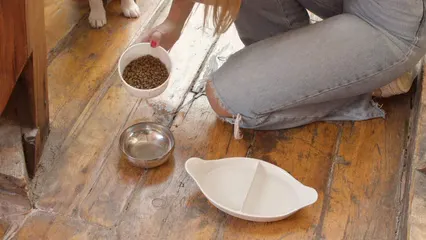
Summary
Food guarding behavior in dogs, also known as resource guarding, is a common yet complex issue that stems from instinctual survival mechanisms. This behavior manifests when dogs feel threatened about losing something valuable, such as food, toys, or space. It often includes signs like growling, stiffening, and blocking access to the guarded resource. Recognizing these behaviors is the first step in addressing them.
Understanding the motivations behind food guarding is critical. Factors such as past trauma, anxiety, and territorial instincts can contribute to this behavior. Fortunately, there are effective strategies to manage and prevent resource guarding, including positive reinforcement training, creating a safe environment, and fostering trust through consistent interaction.
Using positive reinforcement techniques can significantly help in managing food guarding behaviors. Learn more about effective techniques.
By employing techniques like desensitization, counterconditioning, and trade-up exercises, you can help your dog learn that sharing is a rewarding experience. Importantly, you should avoid punitive measures, as these can exacerbate fear and lead to aggression. Instead, focus on building a positive association with your presence around their food and belongings.

Also, consider investing in a Dog Training Book: “The Culture Clash” by Jean Donaldson. This book delves into the dynamics of dog behavior and offers insights that can help you understand your pup’s instincts better. With humor and clarity, it’s a must-read for any dog owner!
In this article, we’ll explore the nuances of food guarding behavior, practical tips for managing it, and provide insights on fostering a trusting relationship with your dog. Whether you’re a new pet owner or a seasoned dog parent, you’ll find actionable advice to create a peaceful coexistence with your four-legged friend.

Understanding Resource Guarding in Dogs
What is Resource Guarding?
Resource guarding is when a dog protects items they consider valuable, be it food, toys, or even their favorite sunny spot on the floor. This behavior can manifest in various ways. Some dogs may growl, snap, or even bite if they feel someone is too close to their prized possession. Others might simply freeze or stiffen up, sending a clear message: “This is mine, back off!”
But why do dogs exhibit such protective behaviors? It’s rooted in instinct. In the wild, dogs had to compete with others for limited resources. If they didn’t guard what they had, they risked going hungry. This survival instinct still lingers in our domesticated dogs, leading to food guarding behaviors we often see. While it may seem amusing when your pup hoards a bone, it’s essential to recognize this behavior can escalate into serious issues if left unaddressed. Understanding this instinct is the first step in managing and preventing resource guarding effectively.

Signs of Resource Guarding
Recognizing the signs of resource guarding is key to addressing it. Some signs are glaringly obvious, while others are more subtle.
Obvious signs include:
- Growling: A low rumble that signals discomfort.
- Snapping: A quick bite that serves as a warning.
- Biting: In more extreme cases, this can happen if a dog feels threatened.
Less overt signs can include:
- Stiff Body Posture: Your dog may suddenly become rigid when approached.
- Avoiding Eye Contact: A dog may look away to avoid confrontation.
- Rapid Eating: If your dog gobbles down food as if it’s a race, they might be guarding against perceived threats.
Other behaviors include lowering their body posture, blocking access to items, or even running away with their food or toys. These subtle signals can indicate a dog’s internal anxiety about losing something they value. Paying attention to these signs can help you intervene before the behavior escalates, ensuring a happier and safer environment for both you and your furry friend.

Causes of Food Guarding Behavior
Psychological Factors
Food guarding behaviors often stem from psychological issues. Anxiety and fear are major players here. If a dog has experienced trauma, they may become defensive over their possessions. For instance, a rescue dog might have been in a situation where food scarcity was a real threat, leading them to protect their resources fiercely.
Genetics can also play a role. Certain breeds, like terriers, might be more prone to guarding behaviors due to their history. They were bred to hunt and protect, which can translate into more significant guarding instincts. Understanding these psychological factors is crucial for addressing the root causes of food guarding.

Environmental Influences
The environment where your dog lives can heavily influence their guarding behavior. For instance, multi-dog households often lead to competition for resources. If dogs are fed together, they might feel the need to guard their food bowls against their siblings.
Moreover, a lack of socialization can exacerbate guarding behaviors. Dogs that haven’t been exposed to various situations and people may view new encounters as threats. This fear can lead to increased guarding tendencies. By ensuring a well-managed environment and promoting positive socialization, you can help mitigate these behaviors before they become problematic.

Managing Food Guarding Behavior
Immediate Steps to Take
If your dog displays food guarding behavior, it’s crucial to act wisely. First, observe from a distance. Allow your furry friend to enjoy their meal without interruption. Approaching a dog during mealtime can trigger anxiety and aggression. Your presence should be a source of comfort, not a threat.
Never punish or scare your dog. This approach can backfire, worsening their anxiety. Instead, let them know that you’re not a threat. If you must approach, do so calmly. Avoid sudden movements and loud noises. This helps create a safe environment for your dog.
If guarding behavior escalates, consider creating a feeding schedule. Feeding in a quiet area can reduce distractions and minimize competition, especially in multi-pet households. If your dog feels secure while eating, they’re less likely to guard their food.
In extreme cases, consult a professional dog trainer or behaviorist. They can provide tailored advice and support, ensuring that you and your pet navigate this behavior effectively. Remember, your goal is to foster trust and understanding, not fear. With the right approach, your dog will learn that sharing space around food can be a positive experience.

Training Techniques
Positive Reinforcement is your best friend when tackling food guarding. Use treats and praise to encourage sharing behavior. For instance, while your dog eats, drop tasty treats near their bowl. This teaches them that your presence brings good things. Over time, they’ll associate you with positive experiences, reducing anxiety.
Next, consider Desensitization and Counterconditioning. This technique involves gradually exposing your dog to your presence during mealtime. Start by standing a distance away while they eat, then slowly decrease that distance over time. Each time they remain calm, reward them with treats. This helps change their emotional response, making them feel more secure when you’re nearby.
Another effective method is Trade-Up Exercises. Teach your dog that relinquishing an item leads to better rewards. For instance, if your dog has a toy, show them a higher-valued item, like a squeaky toy or a treat. Encourage them to drop the first item to get the better one. This way, your dog learns that sharing can be rewarding!
Incorporate these techniques consistently. With patience and practice, your dog will develop a more positive attitude toward sharing their food and toys.

Preventing Food Guarding Behavior
Early Intervention Strategies
Prevention is key when it comes to food guarding. Start by training your puppy early. This sets the foundation for positive behavior around food and toys. Use consistent positive experiences to build their confidence. When your puppy is eating, drop treats nearby. This teaches them that your presence is a positive experience, reducing the chances of guarding behavior developing.
Also, ensure that your puppy has access to plenty of food and toys. The more resources they have, the less likely they’ll feel the need to guard them. Create a safe space for meals, away from distractions. Supervise playtime with toys, and encourage sharing. Use games that promote cooperation and sharing, fostering a sense of security in your puppy.
Lastly, consistently engage in socialization. Expose your puppy to various environments, people, and animals. This builds their confidence and reduces fear-based guarding behaviors. By implementing these early intervention strategies, you set your puppy up for success. A well-adjusted dog is less likely to develop food guarding behaviors as they grow.

Managing Multi-Pet Households
In multi-pet households, competition for resources can spark anxiety and food guarding behaviors. To create a peaceful atmosphere, establish clear feeding and playtime routines. Feeding pets separately is a great first step. Designate specific areas for each pet during mealtime. This way, they can chow down without feeling threatened by their housemates.
Consider using feeding stations with barriers or gates to provide personal space. You can also try staggered feeding times. This keeps one pet busy while the other eats, reducing the urge to guard.
Playtime is another opportunity to minimize competition. Rotate toys regularly to keep things fresh and exciting. This way, pets won’t feel the need to guard their favorite items. Supervised play sessions can also help manage interactions. Always observe how your pets interact and step in if you notice signs of tension.
When children are involved, extra supervision is crucial. Kids may not understand a dog’s warning signs. Teach them to respect the dog’s space, especially during mealtime. Use baby gates to create boundaries, allowing pets a safe space. Remind children to avoid approaching dogs while they eat or play with their toys.
By implementing these strategies, you can foster a more relaxed environment for all your pets. The result? Happy pets and a harmonious home!

Creating a Safe Environment
Environmental Management
Creating a safe environment is vital for managing food guarding behaviors. Start by reducing potential triggers. Identify areas where your dog feels most anxious about resources. Keep high-value items out of reach. This includes toys, food bowls, and treats that could lead to guarding.
Providing separate spaces for feeding and playing is essential. Designate quiet areas for meals, away from distractions. This allows your dog to enjoy their food without feeling threatened. Use crates or playpens to create personal zones where dogs can retreat when feeling overwhelmed.

Consider using Puzzle Feeder Dog Bowls to prevent rapid eating. These help dogs take their time, reducing anxiety about finishing their meal too quickly. Encourage your dog to relax by adding some calming music or scents to their feeding area.
Lastly, keep an eye on the dynamics between pets. If you notice any aggressive behaviors, intervene quickly. Managing interactions effectively can significantly reduce the risk of food guarding.

Encouraging Calm Behavior
Creating a relaxing atmosphere during mealtimes is crucial. Establish a consistent routine for feeding. Dogs thrive on predictability, and a regular schedule can help them feel secure. Feed your dog at the same time every day. This builds anticipation and reduces anxiety around mealtime.
Before meals, engage your dog in calming activities. Short walks or gentle play can help release pent-up energy. This way, they’re more relaxed when it’s time to eat.
During meals, avoid distractions. Turn off the TV and limit noise to create a peaceful environment. If your dog tends to rush their food, try hand-feeding or using a Dog Treat Dispenser Toy. This encourages slower eating, allowing for a more relaxed experience.
Also, reward calm behavior. If your dog remains relaxed while eating, praise them. This reinforces positive associations with mealtime. By fostering a calming environment and routine, you’ll help your dog feel more secure during meals, reducing the likelihood of guarding behaviors.

Conclusion
Understanding and managing food guarding behavior in dogs is vital for a harmonious household. When dogs feel the need to protect their food, it can lead to tension and stress, not just for them but for everyone involved. Recognizing the signs early on is crucial. Those little growls or food hoarding tactics are not just quirky habits; they signal deeper issues at play.
Addressing these behaviors begins with understanding their roots. Factors like past trauma, anxiety, or territorial instincts often contribute to this behavior. Thankfully, there are effective strategies you can use to help your dog feel secure in their environment. Patience and consistency are your best allies in this journey.
Using positive reinforcement techniques will encourage sharing and trust. With time and a sprinkle of professional guidance, you can transform those guarding instincts into a relationship built on cooperation and love. So, don’t despair if your dog seems overly protective of their food. With the right approach, you can help them learn that sharing can be just as rewarding as keeping it all to themselves. A little effort today can lead to a peaceful coexistence tomorrow!

FAQs
Consider using a Dog Anxiety Vest to help your pup feel more secure during stressful situations. This can be especially beneficial in multi-pet households where competition for resources may heighten anxiety.
Please let us know what you think about our content by leaving a comment down below!
Thank you for reading till here 🙂
All images from Pexels

